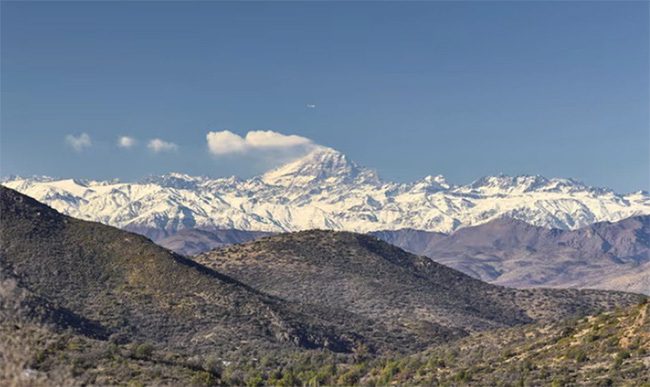Unusual temperatures in winter in the Andes Mountains, South America, have soared to 37 degrees Celsius. Scientists warn that the worst may still be yet to come.
According to The Guardian, the heatwave in the Andes, central Chile, is causing snow to melt at depths below 3,000 meters. This will have a cascading impact on communities living in the lower valleys, who rely on meltwater during spring and summer.
Raul Cordero, a climate scientist at the University of Groningen, noted that August 1st might have been the warmest winter day in northern Chile in the past 72 years. At the Vicuña Los Pimientos station in the Coquimbo region, temperatures have risen to 37 degrees Celsius due to a combination of global warming, El Niño, and eastern gusts known locally as Terral winds, which bring dry and hot weather.

Snow on the Andes Mountains, Chile. (Photo: Shutterstock).
According to the blog Extreme Temperatures Around The World, dozens of weather stations at elevations above 1,000 meters have recorded temperatures exceeding 35 degrees Celsius during winter.
Cordero expressed that the unusually warm air at these elevations is concerning. He pointed out that the main issue is that high temperatures are exacerbating drought conditions in eastern Argentina and Uruguay and accelerating the melting of snow.
Meanwhile, the lack of clean water has become a serious issue around the capital Montevideo in Uruguay, where reservoirs are running dry and tap water is undrinkable.
South America has experienced its warmest recorded periods from January to July. Chile is one of the countries most severely affected, with numerous wildfires occurring earlier this year and prolonged drought. Cordero noted that Santiago is undergoing its ninth heatwave since January and is expected to break the record of 10 annual heatwaves set in 2020.
Expert Marcos Andrade, Director of Atmospheric Physics at the Universidad Mayor de San Andrés in La Paz, stated that the Andean plateau between Bolivia and Peru has also experienced “unusual” weather since the beginning of the year.
“In Puno, across Lake Titicaca, residents have endured the driest January recorded in 59 years. In May, we suffered a storm that brought 20% of the usual annual rainfall. Winter has also been abnormally warm, with some regions breaking temperature records,” said Andrade.
He expressed concern that worse may be ahead as the Southern Hemisphere enters summer. El Niño typically peaks at the end of the year. He believes the most pronounced effects of extreme weather phenomena have yet to occur.
Meanwhile, several cities in Brazil, Argentina, and Uruguay have recorded unprecedented temperatures. Environmental consultant Karla Beltrán reported that in 2023, Argentina’s capital Buenos Aires recorded its highest temperature ever at 38.6 degrees Celsius on March 11, while the city of Mercedes in Uruguay reached a new record of 40.5 degrees Celsius.
Beltrán noted that this heatwave aligns with the latest report from the Intergovernmental Panel on Climate Change. The report highlights that southern South America is particularly vulnerable to high heatwaves. Studies have shown that northern South America—from the Amazon region to the Pacific coast and the Atacama Desert—will experience more frequent and severe heatwaves.
“With the emergence of the El Niño phenomenon, it is expected that in the coming years, this region will have to endure rising temperatures that are already high. We need to take adaptive measures to avoid the risk of fatalities and larger disasters,” Beltrán warned.
Chico Geleira, a climate and oceanography professor at the Federal University of Rio Grande do Sul and Deputy Director of Brazil’s Climate and Polar Center, also expressed concern about this weather trend.
“There is no doubt that winter temperature records in Chile and in some areas of South America are very unusual. The high-pressure system occurring with greater intensity and persistence in the Southern Hemisphere has driven warm air, directly creating extreme temperatures. High pressure is likely to persist and intensify in the upcoming decades alongside climate change,” Geleira predicted.


















































